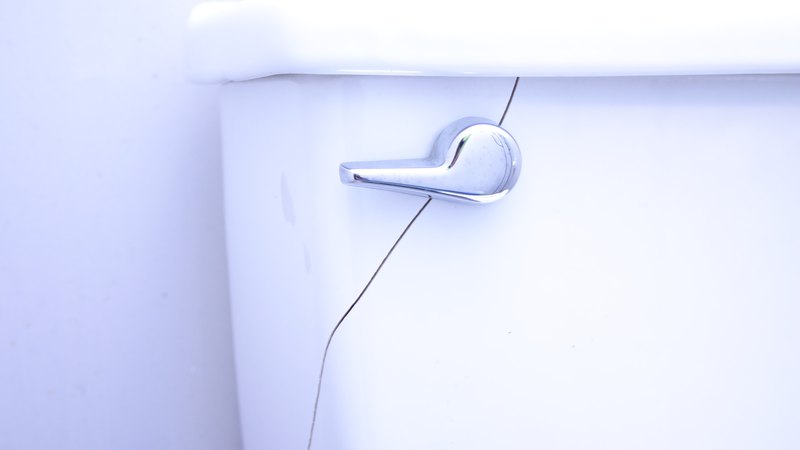
Cracked Toilet Tank: A Complete Guide to Repair
Discover preventive measures to ensure your toilet tank remains in excellent condition, helping you maintain a safe and efficient bathroom environment.
A cracked toilet tank is a common but serious plumbing issue that can cause significant water damage and disrupt your daily routine. Austin Area Plumbing, our plumbing service, is committed to helping you resolve plumbing problems efficiently. In this comprehensive guide, we will cover why a cracked toilet tank is problematic, what causes it, and how you can fix it yourself.
Cracked Toilet Tank: Why Is This Problem?
A cracked toilet tank is more than just a nuisance; it poses several risks that can lead to both immediate and long-term damage. Understanding why this issue is a problem can help emphasize the importance of addressing it promptly.
Impact on Home and Health
A cracked toilet tank can result in water leaks that may cause:
- Water Damage: Leaking water can damage floors, walls, and surrounding areas, leading to costly repairs and potential mold growth.
- Increased Water Bills: Continuous leaks from the tank can cause your water bill to skyrocket, as water is wasted through the cracks.
- Unpleasant Odors: Standing water around a leak can lead to unpleasant smells and unhygienic conditions.
- Inconvenience: A malfunctioning toilet can disrupt daily activities and create a significant inconvenience for you and your family.
Long-Term Impact of Delayed Repairs
- Structural Damage: Continuous water exposure can compromise the structural integrity of flooring and surrounding areas, leading to more severe damage.
- Costly Repairs: Ignoring a cracked tank can result in more extensive damage, making cracked toilet tank repairs more expensive and complex.
What Causes a Toilet Tank to Crack?

Understanding the causes of a cracked toilet tank can help you prevent future issues and maintain your toilet in good condition. So what causes a toilet tank to crack? Here are the primary factors that contribute to this problem:
Aging or Wear and Tear
Over time, the ceramic material of a toilet tank can become brittle. Continuous exposure to water and the weight of the tank can cause it to develop cracks. Older tanks are particularly susceptible to damage due to the natural degradation of the material.
Extreme Temperature Changes
Toilet tanks are often exposed to fluctuating temperatures, especially in regions with extreme weather. Rapid changes in temperature can cause the ceramic to expand and contract. This constant movement can lead to stress fractures and cracks over time.
Impact Damage
Accidental impacts, such as dropping heavy objects or rough handling during cleaning, can cause cracked and leaking toilet tanks. Even minor impacts can cause significant damage if the tank is already weakened.
Manufacturing Defects
Occasionally, defects in the manufacturing process can lead to inherent weaknesses in the toilet tank. These defects can manifest as cracks or fractures that become apparent over time.
How to Fix a Cracked Toilet Tank?
Discovering a crack in your toilet tank can be alarming, but acting quickly can prevent more serious damage and costly repairs. A sealed, cracked toilet tank not only risks water damage to your bathroom but can also lead to increased utility bills and potential health hazards from mold and mildew. Addressing the issue promptly is essential to maintaining the functionality of your toilet and avoiding further complications. With these instructions, you will know how to fix a cracked toilet tank.
1. Assess the Crack
Carefully examine the crack to determine its size, location, and severity. Small cracks or hairline cracks in toilet tanks can often be repaired with sealant, while larger cracks may necessitate a complete tank replacement.
2. Turn Off the Water Supply
If you don’t know where to start or how to fix a crack in the toilet bowl, begin by turning off the water. Shut off the valve behind the toilet and turn it off. Flush the toilet to drain the tank completely. This step is crucial to prevent any additional water damage during the repair process.
3. Dry the Area
Ensure that the tank and the area around it are completely dry before starting the repair. Use towels, a sponge, or a fan to remove any excess moisture. This will ensure that the sealant adheres properly.
4. Apply Epoxy or Sealant
Choose a high-quality waterproof epoxy or ceramic sealant designed for toilet repairs. Follow the manufacturer’s instructions on how to repair a cracked toilet tank carefully:
- Preparation: Clean the crack thoroughly to remove any debris or residue.
- Application: Apply the epoxy or sealant over the crack, ensuring full coverage.
- Drying: Allow the repair material to dry completely according to the product instructions.
5. Refill and Test
Once the repair material has cured, slowly turn the water supply back on. Allow the tank to fill and monitor the repaired area for any signs of leaks. If the tank still leaks, you may need to apply a second layer of sealant or consider replacing the tank.
6. Replace the Tank if Necessary
If the crack is too large or the repair does not hold, it may be time to replace the toilet tank. This involves:
- Removing the Old Tank: Disconnect the tank from the bowl and remove any bolts or fittings.
- Installing the New Tank: Position the new tank on the bowl, secure it with bolts, and connect the water supply.
- Testing: Check for leaks and ensure the new tank functions correctly.
Can You Seal a Cracked Toilet Tank Yourself?
Sealing a cracked toilet tank yourself is often feasible for minor cracks, especially if you are comfortable with basic DIY repairs. How to repair a toilet tank?
Assess Your Skills
- Basic DIY Skills: If you have experience with simple home repairs, sealing a small crack can be a manageable task.
- Tool Availability: How to seal a cracked toilet tank if you don’t have materials? So ensure you have the necessary tools and materials, including epoxy or sealant, towels, and a sponge.
Follow Instructions Carefully
- Read Labels: Follow the manufacturer’s instructions for the repair product you choose.
- Ensure Proper Drying: Make sure the sealant or epoxy is completely dry before refilling the tank.
When to Call a Professional
- Large or Complex Cracks: If the crack is extensive or if you are unsure about the repair, it’s best to consult a professional plumber.
- Persistent Leaks: If the repair does not resolve the issue, professional help can provide a more permanent solution. So sometimes, instead of thinking you can seal a cracked toilet tank by yourself, it’s better to call a professional.
Preventing Future Cracks Of Toilet Tank
Preventing seal cracks in your toilet tank is essential for avoiding repeated repairs and costly replacements. Regular maintenance is key to preserving the integrity of your toilet tank. Make it a habit to inspect the tank periodically for any signs of wear and tear or potential cracks. Keeping the tank clean is equally important; use non-abrasive cleaners and steer clear of harsh chemicals that could damage the ceramic material.
Temperature control also plays a significant role in preventing cracks. To minimize stress caused by temperature fluctuations, avoid placing the toilet tank near direct heat sources or exposing it to extreme cold. In colder climates, insulating the tank can be effective so as not to ask questions like “How to repair a cracked porcelain toilet tank?” later.
Handling the toilet with care is another important factor. Be cautious when cleaning around the toilet or moving items near it to avoid accidental impacts that could cause damage. Additionally, ensure that the toilet is used properly and avoid placing heavy objects on the tank, as this can contribute to structural weaknesses and cracks.
By following these preventive measures, you won’t need to think, “Can you repair a cracked toilet tank?” in the future.
Quick Fix for Leaking Toilet Tank with Austin Area Plumbing
A cracked and leaking toilet tank requires prompt attention to prevent further damage and inconvenience. At Austin Area Plumbing, we are dedicated to providing expert plumbing solutions and quick fixes for leaking toilet tanks. As a family, veteran, and woman-owned business, we offer personalized service and financing options for larger plumbing jobs to ensure you get the help you need.
If you encounter a cracked toilet tank or any other plumbing issue, don’t hesitate to contact Austin Area Plumbing. Our experienced team is ready to assist you with efficient and reliable plumbing solutions.
Latest News and Useful Tips from Austin Area Plumbing
Discover the pros and cons of tankless vs. traditional water heaters. Learn which option is energy-efficient, cost-saving, and best for your home needs.
Explore key qualities to look for in water heater installation companies. Ensure optimal performance and reliability for your home's hot water needs with expert insights and tips.
Don't let this annoying noise disrupt your day. Our professional plumbers are ready to diagnose and fix the issue quickly. Call and get your toilet running quietly again!